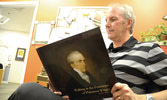Local author pens history book on one of his ancestors -- who happens to be Philemon Wright

A new book on the founder of Hull and the first American pioneer of the Ottawa Valley entitled Walking in the Footsteps of Philemon Wright has the potential to change the way many see the National Capital Region’s history. Incidentally, the reason behind the book was rather modest.
“The purpose was simply to amass the material that I have researched over the past 15 to 20 years and pen the stories that I am aware of. I was also looking to identify the locations that I was brought to as a child and that I brought my children to in order to ensure it was all in a book; otherwise, what happens is that when I’m gone they will forget,” explained Aylmer resident and author Richard Henderson.
The interest in the tabletop book published by Shutterfly grew after Mr Henderson made presentations as part of the 200th anniversary of Nicholas Sparks' arrival in Ottawa. Because of his interest and his knowledge of the Wrights, Mr Henderson was asked to join the anniversary committee, which lead to more presentations about the link between Nicholas Sparks and the Wrights. In 1826, Sparks married Philemon Jr. Wright’s widow Sally Olmstead Wright.
The focus of his book is not on Nicholas Sparks but, in a way, setting the record straight on Philemon Wright.
“There are several recent historians that look upon Philemon Wright and make conclusions that his settlement founded in 1800 was unsuccessful because it was, for instance, soon outstripped by Ottawa. Even Chelsea got to have more importance,” said Henderson. “However, it is wrong minded because he wasn’t trying to create a town or a city.”
“He wasn’t a developer,” Henderson said. “He was a farmer, and his idea was to create a bucolic agricultural community.
“Some say he was a flop as businessman. Well, he wasn’t a businessman. Some argue that he was a flop as a city creator. Well, he wasn’t trying to create a city. How was he as a farmer? Well, he had 160 square kilometres of farmland. People in the United Kingdom and in the United States knew of Philemon Wright’s settlement which was considered one of the largest agricultural communities in Lower Canada. It was one of the most successful agricultural communities in all of North America. It was known as being extremely successful.”
However, money was running short and, as Mr Henderson explained, it was in 1806 that Philemon Wright turned to the timber trade to keep his dream of
creating a utopian farming community. The timber trade continued to flourish mainly because of Philemon Wright’s sons who, unlike their father, sold off much of the land. However, Philemon Sr’s focus remained farming.
“When he retired and handed over the reins to his sons, he did not retire in the city where he had a beautiful home, he retired in the countryside in the Onslow Township. To this day, we don’t know exactly where he lived,” explained Henderson.
The forgotten son
Besides attempting to show Philemon Wright in a different light, Mr Henderson also set out to put some of the relational stories together in his book.
“For example, Philemon Wright’s son, Philemon Wright Jr, who is my third great-grandfather, accidentally died at 39. He broke his neck when his carriage overturned near la Rivière Rouge (just west of Lachute). It was in December 1821 and, at the time, Hull was in its infancy. There was only a cemetery with simple crosses, and St James Church (on Promenade du Portage) was two years away from being built. Where he was interred was lost.”
As Mr Henderson explained, it was not only that valuable piece of information that was forgotten, but also Philemon Jr’s importance during the early days of the settlement.
“Because of his early death, his brothers, Ruggles and Tiberius, take more importance in the town’s evolution and later in the timber trade. Both, particularly Ruggles, made good names for themselves, but the story of Philemon Jr is lost,” explained Mr Henderson. There’s also no portrait of Philemon Jr. One of Henderson’s goals is to shine light on Philemon Jr’s role during the first challenging years of Wright's Town, later renamed Hull.
“During the settlement of the town, intended to be a bucolic agricultural community, Philemon Jr worked shoulder to shoulder with his father, as he was the second man of the home, being the eldest child. In 1808, the settlement and the crops pretty much all burned down and, if it hadn’t been for Philemon Jr, Philemon Sr would have probably returned to Massachusetts,” said Henderson. “It was Philemon Jr who got the associates together. Within six weeks, the sawmill was reconstructed and six months later, much of the burned down infrastructure was rebuilt.”
Prior to his death, Philemon Jr was managing all the farms, including the one in Aylmer, the Chaudière Farm. It was at his death that Philemon Sr’s nephew, Charles Symmes, came over and began running the Aylmer farm. Symmes is considered the founder of Aylmer.
Information: rick@actcompany.ca


